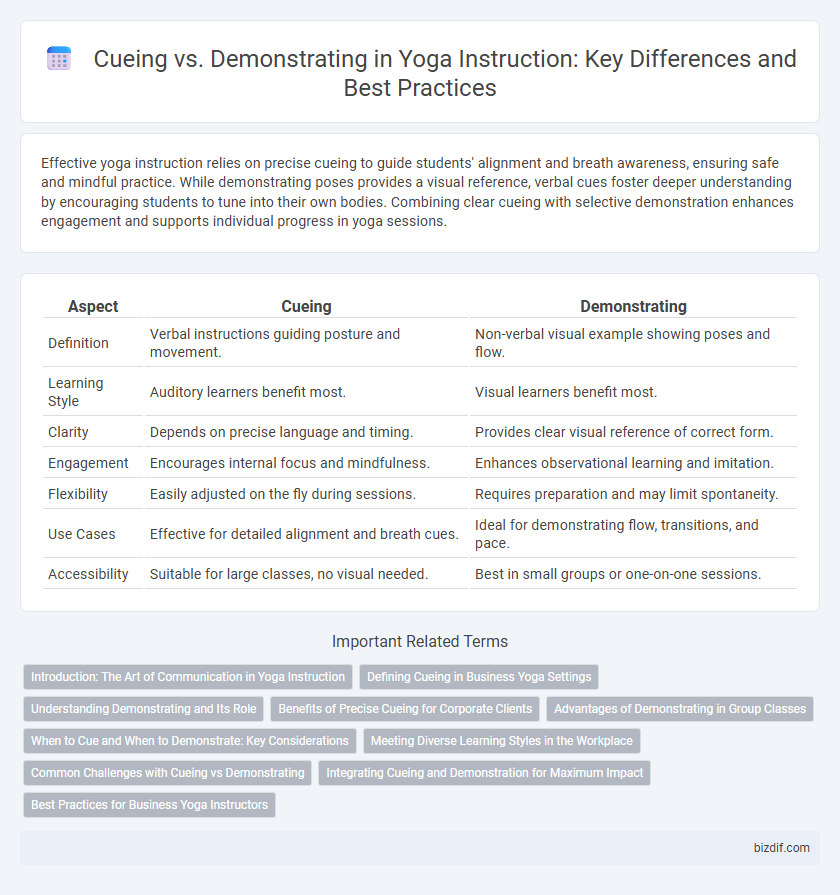Effective yoga instruction relies on precise cueing to guide students' alignment and breath awareness, ensuring safe and mindful practice. While demonstrating poses provides a visual reference, verbal cues foster deeper understanding by encouraging students to tune into their own bodies. Combining clear cueing with selective demonstration enhances engagement and supports individual progress in yoga sessions.
Table of Comparison
| Aspect | Cueing | Demonstrating |
|---|---|---|
| Definition | Verbal instructions guiding posture and movement. | Non-verbal visual example showing poses and flow. |
| Learning Style | Auditory learners benefit most. | Visual learners benefit most. |
| Clarity | Depends on precise language and timing. | Provides clear visual reference of correct form. |
| Engagement | Encourages internal focus and mindfulness. | Enhances observational learning and imitation. |
| Flexibility | Easily adjusted on the fly during sessions. | Requires preparation and may limit spontaneity. |
| Use Cases | Effective for detailed alignment and breath cues. | Ideal for demonstrating flow, transitions, and pace. |
| Accessibility | Suitable for large classes, no visual needed. | Best in small groups or one-on-one sessions. |
Introduction: The Art of Communication in Yoga Instruction
Effective yoga instruction hinges on the art of communication, where cueing and demonstrating serve as essential techniques to convey posture and alignment. Cueing employs precise verbal prompts that guide students' awareness and movement, enhancing their internal focus and mindfulness during practice. Demonstrating visually models poses, enabling learners to observe form and flow, which complements verbal cues and supports diverse learning styles.
Defining Cueing in Business Yoga Settings
Cueing in business yoga settings involves providing clear, concise verbal instructions that guide participants through poses and breathing techniques, enhancing focus and safety without requiring physical demonstration. Effective cueing emphasizes alignment, breath control, and mindful movement, enabling employees to deepen their practice independently. This method supports scalable group sessions, fosters mental clarity, and reduces the need for close physical interaction in corporate environments.
Understanding Demonstrating and Its Role
Demonstrating in yoga instruction serves as a powerful visual cue that enhances student comprehension by providing a clear example of posture alignment and movement flow. Effective demonstrations communicate subtle body mechanics that verbal cues alone might miss, allowing students to internalize proper technique and avoid injury. Instructors who master demonstrating can bridge the gap between explanation and execution, facilitating a deeper learning experience in the yoga practice.
Benefits of Precise Cueing for Corporate Clients
Precise cueing in yoga instruction enhances focus and alignment, reducing the risk of injury for corporate clients who often face physical strain from desk-bound work. Clear, concise verbal guidance supports mental clarity and stress relief, promoting improved productivity and well-being in the workplace. Tailored cueing fosters engagement and inclusivity, accommodating varying skill levels and physical abilities within corporate groups.
Advantages of Demonstrating in Group Classes
Demonstrating yoga poses in group classes provides clear visual guidance that helps students understand alignment and movement more effectively than verbal cues alone. This method enhances learner engagement by offering a consistent reference that accommodates different learning styles and reduces misunderstandings. Visual demonstration also accelerates skill acquisition by allowing students to mimic precise techniques, improving overall class cohesion and safety.
When to Cue and When to Demonstrate: Key Considerations
Effective yoga instruction balances cueing and demonstrating to enhance student understanding and safety. Cueing is optimal when precise verbal guidance is needed to align posture or control breath, especially in complex or subtle poses. Demonstrating becomes crucial for visual learners or when illustrating dynamic sequences and transitions that require spatial awareness and flow.
Meeting Diverse Learning Styles in the Workplace
Effective yoga instruction in the workplace requires a balance between cueing and demonstrating to accommodate diverse learning styles such as auditory, visual, and kinesthetic. Precise verbal cues support auditory learners, while clear physical demonstrations engage visual learners and facilitate kinesthetic learners by modeling movement. Tailoring instruction to these varied modalities enhances employee engagement, retention, and overall wellness outcomes.
Common Challenges with Cueing vs Demonstrating
Common challenges with cueing in yoga include clients misinterpreting verbal instructions due to varying levels of body awareness and language comprehension. Demonstrating poses can sometimes overwhelm beginners who struggle to replicate complex movements without step-by-step guidance. Balancing precise verbal cues with clear visual demonstrations enhances understanding, reduces injury risk, and improves overall practice outcomes.
Integrating Cueing and Demonstration for Maximum Impact
Integrating cueing and demonstration enhances yoga instruction by combining verbal clarity with visual guidance, allowing students to understand and embody poses more effectively. Precise cueing directs attention to alignment, breath, and movement nuances, while demonstration models correct form and flow, catering to diverse learning styles. This integrated approach fosters deeper engagement, reduces injury risk, and accelerates skill acquisition in yoga practice.
Best Practices for Business Yoga Instructors
Effective business yoga instructors prioritize clear, concise cueing to guide diverse student bodies through safe and accessible poses, enhancing class engagement and retention. Combining verbal cues with minimal, precise demonstrations helps accommodate varied learning styles, ensuring students understand alignment and transitions without dependency on visual imitation. Implementing feedback loops to assess student comprehension refines instructional methods, fostering a professional environment that boosts client satisfaction and sustained participation.
Cueing vs Demonstrating Infographic

 bizdif.com
bizdif.com